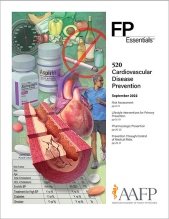
The prevention of cardiovascular disease (CVD) is a quintessentially family medicine subject. Not only is CVD very prevalent, but the risk factors that contribute to it affect so many aspects of both public and individual health. Considering how best to prevent CVD highlights the need for an engaged personal physician, but also a clinician who is able to understand the impact of social drivers of health and community level interventions to prevent disease and improve care.
This edition of FP Essentials addresses CVD prevention from a family medicine perspective. Section One covers individual patient risk assessment. This section discusses the use of risk calculators and other tools to help patients determine their individual risk of CVD. It describes individual lifestyle recommendations and identifies prophylactic drugs to reduce personal CVD risk. If your institutions have begun offering coronary artery calcium scans, this section will help you understand when they are appropriate and how they can be interpreted.
Section Two covers lifestyle interventions for primary prevention of CVD. Many patients are highly motivated to prevent CVD, and many prefer to avoid drugs. However, identifying the most effective methods to reduce this risk can be difficult. This section discusses the evidence behind behavioral counseling for healthy diet and physical activity as well as smoking cessation and other modifiable risk factors.
Section Three discusses pharmacotherapy to prevent CVD. This section details the recent, changing evidence surrounding aspirin for primary prevention. Management of hyperlipidemia, including statins and other lipid-lowering therapies, is also discussed. Finally, this section covers sodium-dependent glucose cotransporter 2 (SGLT2) inhibitors and glucagon-like peptide 1 (GLP-1) agonists and introduces the polypill concept for CVD prevention.
Section Four reviews CVD prevention through the management of medical risk factors, such as diabetes, obesity, and hypertension. Many family physicians are aware that the therapeutic goals for these conditions have varied in the past several years. This section describes the evidence for various endpoints, in addition to discussing the risks and benefits of aggressive medical therapy.
I have found this edition of FP Essentials to be full of helpful, practical information for counseling patients. I hope you and your patients find it useful as well.
Kate Rowland, MD, FAAFP, Associate Medical Editor
Vice Chair of Education and Associate Professor,
Department of Family Medicine
Rush University, Chicago, Illinois
